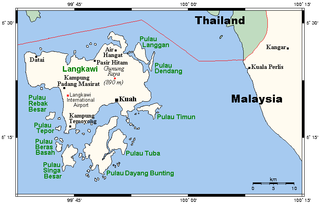Thysanopyge is an extinct genus from a well-known class of fossil marine arthropods, the trilobites. It lived in what is now South America during the early part of the Arenig stage of the Ordovician Period, a faunal stage which lasted from approximately 478 to 471 million years ago.
The Bardahessiagh Formation is a geologic formation in Northern Ireland. It has been described from a locality lying about 3 km NNE of Pomeroy, south of Craigbardahessiagh. It is now known as comprising the former ‘Bardahessiagh Formation’, or Bardahessiagh Beds and the ‘Junction Beds’ that is underlain by a stratigraphical unit not recognised, until fieldwork by the Ulster Museum staff in 1992. The Bardahessiagh Formation is divided into three units, but the summit of the formation is not known. Field evidence indicates that the local top of the formation is characterised by a thrust contact with the Killey Bridge and Tirnaskea Formation, exposed south of the Well Field, which lies 650 metres SSW of Craigbardahessiagh.
The Folkeslunda Limestone is a thin limestone and mudstone geologic formation of Sweden. The formation crops out on the island of Öland to the east of Kalmar, where Folkeslunda is located. Other exposures of the formation are in Dalarna, Jämtland and Östergötland. The Folkeslunda Limestone was deposited in an open marine environment with an estimated water depth of 150 to 200 metres in a eustatically transgressive phase.
The Tucumilla Formation is a Tremadocian geologic formation of southern Bolivia. The sandstones, shales and siltstones crop out in the José María Avilés and Eustaquio Méndez Provinces.
The Iscayachi Formation, in older literature also referred to as Guanacuno Formation, is an extensive Tremadocian geologic formation of western and southern Bolivia. The shales and sandstones were deposited in a shallow marine to pro-delta environment. The formation reaches a thickness of 1,000 metres (3,300 ft).
The Pircancha Formation is a Floian to Dapingian geologic formation of southern Bolivia. The green mudstones, shales and sandstones were deposited in a shallow to open marine environment. The fossil Pircanchaspis rinconensis is named after the formation.
The Obispo Formation is a Dapingian geologic formation of southern Bolivia. The shales and siltstones were deposited in an open marine environment.
The San Lorenzo Formation is a Dapingian geologic formation of southern Bolivia. The dark gray, greenish, and black shale with thin intercalations of white-yellow quartzites were deposited in an open marine submarine fan environment.
The Independencia Formation is a Dapingian geologic formation of western-central Bolivia. The dark to bluish gray schists and phyllites metamorphosed shales were deposited in an open marine environment.
La Ciénega Formation is a Sandbian to Katian geologic formation of south-central Bolivia. The formation comprises silty, clayey, micaceous, fine-grained sandstones with thin intercalations of grey-green to light grey shales.
The San Benito Formation is a Katian geologic formation of central Bolivia. The formation belongs to the Cochabamba Group, overlies the Anzaldo Formation and is overlain by the Cancañiri Formation. The 500 metres (1,600 ft) thick formation comprises a succession of shallow water quartzitic sandstones with minor interbeds of dark grey micaceous siltstones. Shelly fossils have been found at few horizons and consist mainly of linguliformean brachiopods, bivalves, and a few homalonotid trilobite remains. Poorly preserved graptolites occur occasionally in the shaly beds.
The Cancañiri Formation, also named as Cancañiri Tillite, is a Katian to Hirnantian geologic formation of central Bolivia. The pebbly, argillaceous sandstones, shales and siltstones of the up to 1,500 metres (4,900 ft) thick formation, were deposited in a glacial foreshore to deep water turbiditic environment. The formation is named after Cancañiri, a mining town close to Llallagua, where a local legend of a possessed woman is believed. The formation overlies the San Benito Formation in Cochabamba and the Amutara Formation in other parts. The Cancañiri Formation is overlain by the Uncía Formation.
The Catavi Formation is a Pridoli to Emsian geologic formation of northern and central Bolivia. The formation comprises a 456 m (1,496 ft) thick succession of fine-grained, olive to brown sandstones and siltstones, shales and black limestones deposited in a shallow to deep marine environment.
The Gamoneda Formation is an Emsian geologic formation of southern Bolivia. The approximately 340 metres (1,120 ft) thick formation comprises marine micaceous grey siltstones and burrowed grey sandstones and shales.
The Venado Formation is a geological formation of the Agua Blanca Group, in the Eastern Ranges of the Colombian Andes, cropping out along the Venado River in northern Huila. The sequence of pyrite containing dark grey micaceous shales interbedded with siltstones and sandstones dates to the Ordovician period; Middle to Late Floian epoch, and has a maximum thickness of 670 metres (2,200 ft) in the type section.
The Letná Formation is a Late Ordovician geologic formation of the Prague Basin, Bohemian Massif in the Czech Republic. The formation crops out in the Czech capital, more specifically at Letná Hill, after which the formation is named. The type locality is located at Malá Strana, Holešovice district.
The Anzaldo Formation is a Katian geologic formation of central Bolivia. The formation belongs to the Cochabamba Group, overlies the Capinota Formation and is overlain by the San Benito Formation.

The Tenjong Dendang Formation is a geologic formation in Malaysia. The band of graptolite- and trilobite-bearing shales interbedded in limestones preserves graptolite, brachiopod and trilobite fossils dating back to the Hirnantian stage of the Late Ordovician period. The sediments were deposited during the Late Ordovician glaciation.

